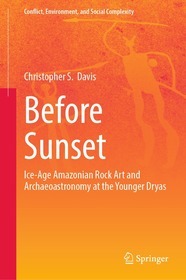
Before Sunset
Ice-Age Amazonian Rock Art and Archaeoastronomy at the Younger Dryas
Sorozatcím: Conflict, Environment, and Social Complexity;
-
12% KEDVEZMÉNY?
- A kedvezmény csak az 'Értesítés a kedvenc témákról' hírlevelünk címzettjeinek rendeléseire érvényes.
- Kiadói listaár EUR 139.09
-
57 687 Ft (54 940 Ft + 5% áfa)
Az ár azért becsült, mert a rendelés pillanatában nem lehet pontosan tudni, hogy a beérkezéskor milyen lesz a forint árfolyama az adott termék eredeti devizájához képest. Ha a forint romlana, kissé többet, ha javulna, kissé kevesebbet kell majd fizetnie.
- Kedvezmény(ek) 12% (cc. 6 922 Ft off)
- Kedvezményes ár 50 765 Ft (48 347 Ft + 5% áfa)
Iratkozzon fel most és részesüljön kedvezőbb árainkból!
Feliratkozom
57 687 Ft

Beszerezhetőség
Megrendelésre a kiadó utánnyomja a könyvet. Rendelhető, de a szokásosnál kicsit lassabban érkezik meg.
Why don't you give exact delivery time?
A beszerzés időigényét az eddigi tapasztalatokra alapozva adjuk meg. Azért becsült, mert a terméket külföldről hozzuk be, így a kiadó kiszolgálásának pillanatnyi gyorsaságától is függ. A megadottnál gyorsabb és lassabb szállítás is elképzelhető, de mindent megteszünk, hogy Ön a lehető leghamarabb jusson hozzá a termékhez.
A termék adatai:
- Kiadó Springer Nature Switzerland
- Megjelenés dátuma 2025. június 21.
- Kötetek száma 1 pieces, Book
- ISBN 9783031933721
- Kötéstípus Keménykötés
- Terjedelem287 oldal
- Méret 235x155 mm
- Nyelv angol
- Illusztrációk XV, 287 p. 209 illus., 207 illus. in color. Illustrations, black & white 672
Kategóriák
Hosszú leírás:
"
Through a presentation of the oldest rock art dated in the Americas, located in Monte Alegre, Brazil, this book analyzes an ancient ecological-astronomy strategy that theoretically made the rapid human migration in the Americas successful. It helps answer two vital questions long held by scholars and the general public alike: How did humans survive the rapid and massive climate changes at the end of the ice age? And how did founding populations (especially in the Americas) manage successful settlement, relatively rapidly, in ecosystems entirely foreign to them? It further initiates questions about the universal role that astronomy (and even astrology) might have played in cognitive human evolution and the success of burgeoning sedentism and eventual ""civilization"" throughout the world. The book makes a substantial contribution because of the wealth of cultural information it provides from Monte Alegre. It explains the author's analysis of pictographs, lithics, and landscape modifications that were excavated there and provides novel findings on the chronology and archaeoastronomy of the art.
This book is indispensable for courses about Paleoindians, peopling of the Americas, environmental anthropology, cosmology, rock art studies, archeoastronomy, paleoecology, paleoethnobotany, and Amazonia. The pan-American indications of this work will appeal to archaeologists, historians, art historians, folklorists, Native American and Indigenous scholars, evolutionists, cognitive scientists, geographers, and the general public.
" TöbbTartalomjegyzék:
"
Introduction: Monte Alegre Rock Art.- Geology and Climate Since the Last Ice Age.- Phenology and Ecology of Monte Alegre State Park.- Historical Accounts of the Rock Art.- Serra Da Lua and Serra Do Sol Rock Art.- Archaeoastronomy at Serra Da Lua and Serra Do Sol.- Stone Tools and Artifacts at Ererê.- Excavation and Investigation at Painel Do Pilao.- Solar-Aligned Pictographs at Painel Do Pilao.- Descendants or Inheritors?.
" Több



